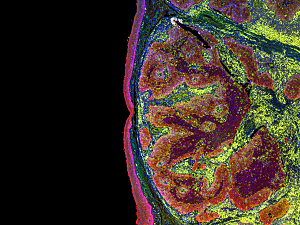A major barrier to the efficacy of cancer immunotherapy is oncometabolism—the metabolic reprogramming that accompanies tumorigenesis, tumor progression, and key aspects of malignant transformation.
Cancer-associated alterations in metabolic pathways facilitate the production of metabolites required for tumor growth as well as inhibition of antitumor immune response. Fortunately, a growing body of research suggests that controlled targeting of those pathways could improve the efficacy of immunotherapy.
Joshua D. Bernstock, MD, PhD, PGY-4 resident in the Department of Neurosurgery at Brigham and Women’s Hospital, Gregory K. Friedman, MD, of the University of Alabama at Birmingham, and colleagues recently reviewed novel therapies that target oncometabolism and tumor immunometabolism. Their report on preclinical and early-phase clinical trial research appears in Oncogene.
Targeting Tumor Preference for Glycolysis
Glucose transporter 3 (GLUT3) is critical to glioblastoma tumorigenesis and cancer stem cell maintenance. GLUT3 inhibitors have been shown in vitro to thwart the growth of patient-derived glioblastoma xenografts.
Increases in proteins related to glucose metabolism, including hexokinase 2 (HK2) and pyruvate dehydrogenase kinase (PDK), have been observed in high-grade gliomas. 3-brompyruvate, an inhibitor of HK2, and dichloroacetate, a PDK inhibitor, have reduced resistance to temozolomide in vitro and in animals with high-grade gliomas.
According to a report in Science Translational Medicine, oral administration of dichloroacetate to patients with glioblastoma resulted in concentrations sufficient to inhibit PDK, suggesting this treatment strategy may be translatable.
Targeting Altered Glutamine Metabolism
IDH1 mutations are common in glioma and result in elevated levels of L-2-hydroxyglutarate (2-HG), an oncometabolite that promotes tumorigenesis. Ivosidenib, a small-molecular inhibitor of IDH1, induces 2-HG suppression. It’s already FDA-approved for the treatment of IDH1-mutated acute myeloid leukemia.
A phase 1 trial of ivosidenib for advanced solid tumors is ongoing, and a case report in Future Medicine described a trial participant with IDH1-mutant glioblastoma who exhibited radiographically stable disease for four years.
Two other drugs in clinical trials for IDH1-mutant glioma are:
- Vorasidenib, a dual IDH1/IDH2 inhibitor designed to facilitate blood–brain barrier penetration
- CB-839, a small-molecule glutaminase inhibitor being trialed in combination with temozolomide and radiation and also in combination with nivolumab
Targeting Indoleamine 2,3-dioxygenase
Indoleamine 2,3-dioxygenase (IDO) converts tryptophan to kynurenine, a process that hinders antitumor immunity in several ways. IDO expression itself fosters an immunosuppressive tumor microenvironment, and in glioblastoma, there’s a clear association between IDO expression and decreased overall survival.
Two IDO inhibitors, indoximod and epacadostat, are in early clinical trials in glioblastoma and other malignant brain tumors. Epacadostat plus nivolumab resulted in a disease control rate of 70% in adults with glioma, according to a report in The Lancet Oncology.
Targeting Toll-like Receptors
Toll-like receptors (TLRs) play a complex role in tumorigenesis and cancer progression, partly by modulating inflammation in the tumor microenvironment. Crucially, though, TLRs can also prime the immune system against malignant cells. Two TLR3 agonists are being investigated in glioblastoma:
- Polyinosine-polycytidylic acid (poly [I:C])—Enhanced response to checkpoint inhibitors in patient-derived glioblastoma cell lines (Oncoimmunology)
- Poly-ICLC (stabilized by lysine and carboxymethylcellulose)—When combined with radiation and temozolomide in adults with newly diagnosed glioblastoma, the median overall survival was 18.3 months (Neuro-Oncology)
Combination Therapy
Checkpoint inhibitors have yielded disappointing results when used as monotherapies in glioblastoma. They are now often being combined with oncolytic virotherapy, vaccines, chimeric antigen receptor T cell therapy, and some of the immunometabolic therapies discussed here.
Challenges to be addressed are how to account for tumor genetic heterogeneity, penetrate the blood–brain barrier, time adjuvant therapy correctly and precisely target the metabolism of tumor cells in the tumor microenvironment.
